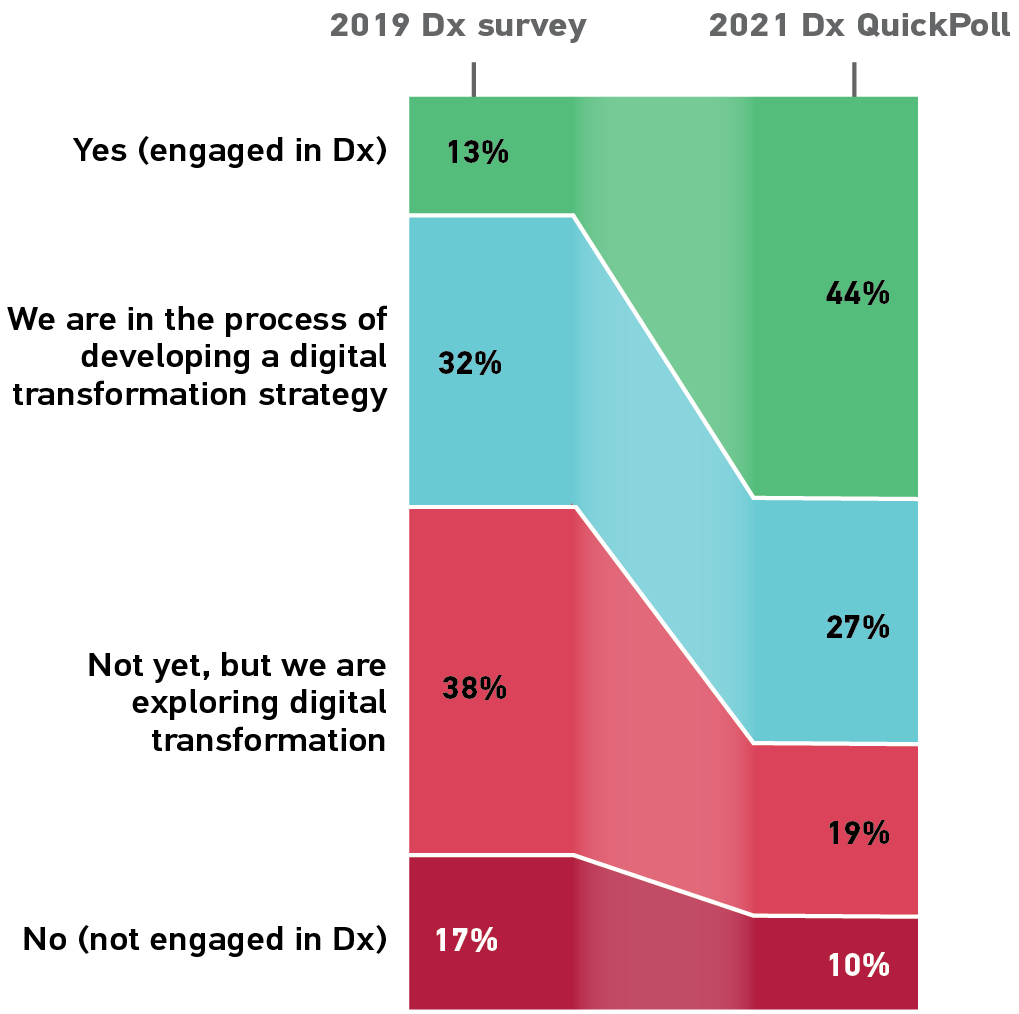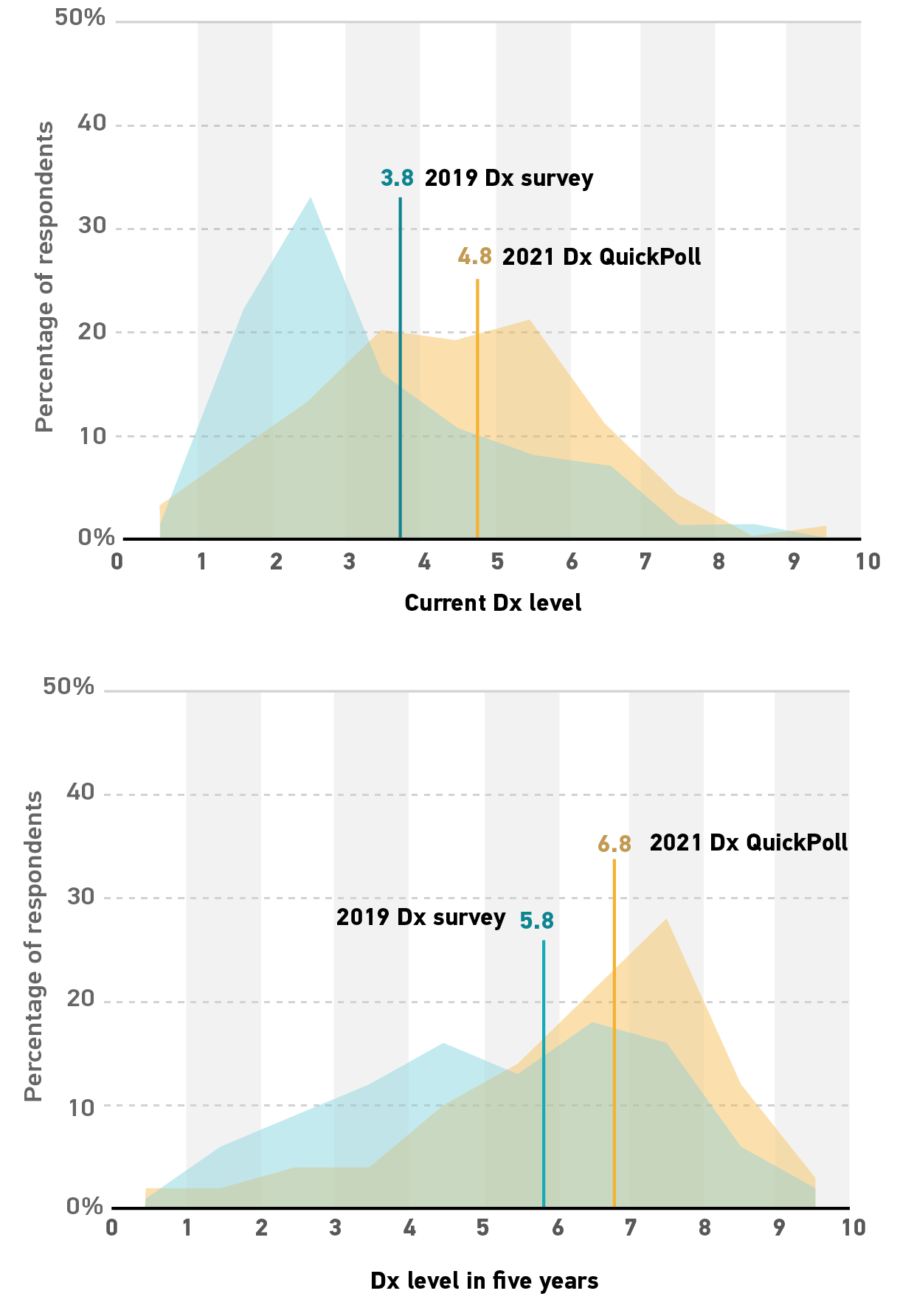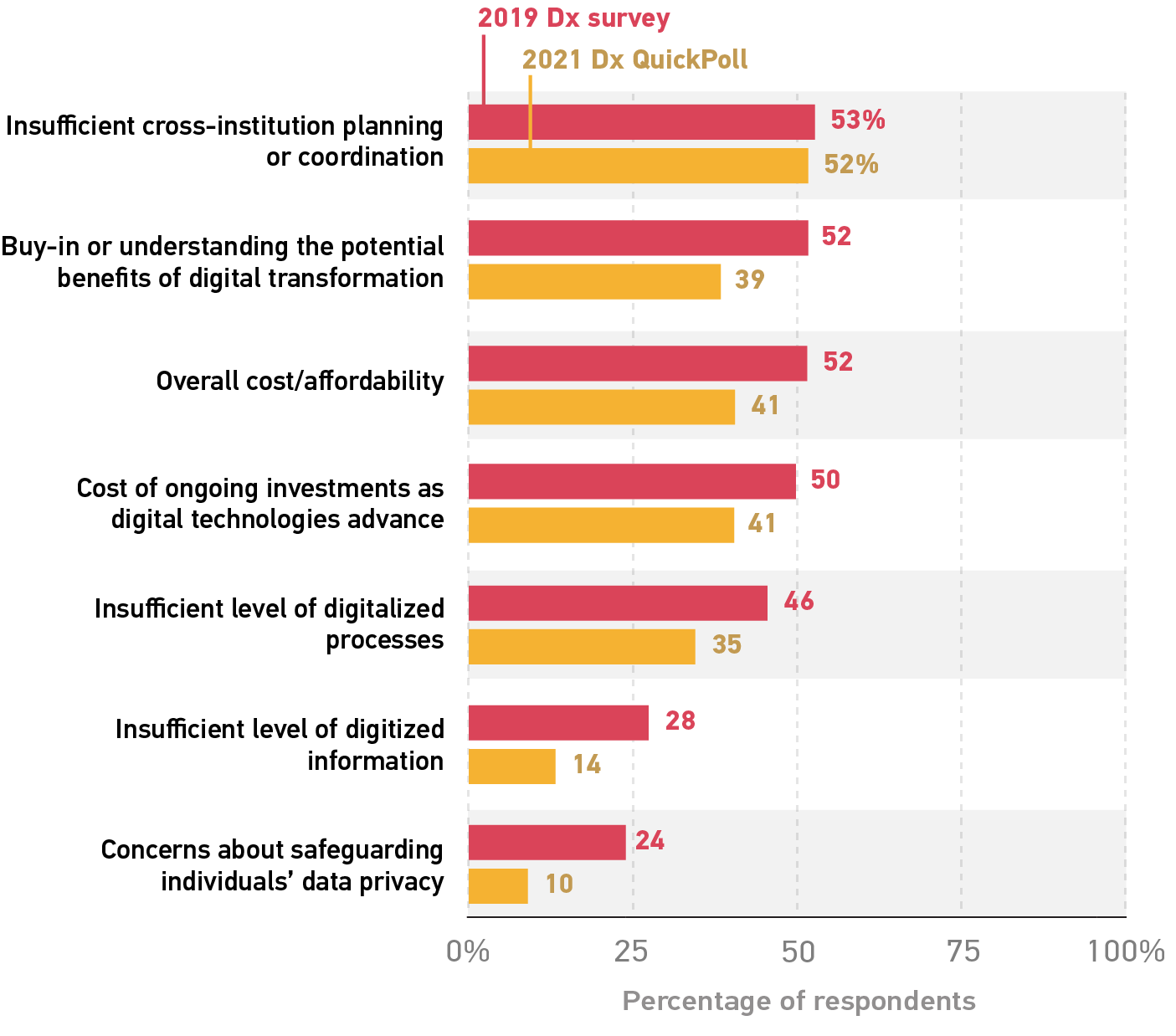Digital transformation in higher education has accelerated throughout (and partly because of) the COVID-19 pandemic. Improved cross-institution collaboration can help institutions maintain their digital transformation momentum into the future.

EDUCAUSE is helping institutional leaders, IT professionals, and other staff address their pressing challenges by gathering and sharing data. This report is based on an EDUCAUSE QuickPoll. QuickPolls enable us to rapidly gather, analyze, and share input from our community about specific emerging topics.Footnote1
The Challenge
Not so long ago, digital transformation (Dx) seemed like an aspirational goal for higher education leaders, an ideal state years away on a future horizon.Footnote2 The sudden emergence of a global pandemic, however, necessitated rapid innovation and forced institutions to accelerate their Dx planning and work, perhaps far beyond even their most ambitious timetables. How far have institutions advanced in their Dx efforts over the past year and a half, and what barriers and opportunities still lie ahead? This QuickPoll takes up these and other questions around institutions' ongoing engagement in Dx.Footnote3
The Bottom Line
Rates of institutional engagement in Dx have increased considerably since 2019, with a plurality of respondents now reporting their institution is engaged in Dx. Institutional barriers to Dx seem to have abated somewhat over that same period of time, though opportunities remain for improving cross-institutional planning and coordination, as well as for implementing Dx more consistently across functional units.
The Data: Instructional Use
Digital transformation is here now. The change from 2019 to the present day in perceived institutional engagement in Dx is striking. In 2019, a majority of IT leaders reported either that their institutions were "not yet" engaged in Dx but were exploring it (38%) or that they simply were not engaged in Dx (17%) (see figure 1). Today, a plurality of IT leaders (44%) report that their institutions are engaged in Dx, with another 27% reporting that they are developing a Dx strategy. Only 29% now report that their institution is not yet or not at all engaged in Dx.

The COVID-19 pandemic has been a Dx accelerant. There seems to be little doubt in respondents' minds that the COVID-19 pandemic has been a factor in accelerating their institutions' Dx journey. More than three-quarters (79%) of respondents reported that the pandemic has spurred Dx at their institution to a "moderate" or "large" extent, while less than 1% of respondents reported that it hadn't sped up Dx at their institution at all.
Institutions are inching closer to ideal future states. Asked in 2019 how closely their institution resembled an idealized digitally transformed institution, IT leaders on average rated their institution a 3.8 on a scale from 1 to 10 (see figure 2 below). When asked where they would expect their institution to be in five years' time, they expected their institution would be at an average of 5.8. Asked the same questions today, IT leaders now on average estimate their institution is a 4.8 and expect their institution to be at a 6.8 in five years' time.

Institution size matters for engagement in digital transformation. Though respondents from institutions of all sizes are more likely to report engagement in Dx now than in 2019, respondents from larger institutions are far more likely to report current engagement in Dx than respondents from smaller institutions (see table 1). More than half (52%) of respondents from institutions with at least 5,000 students reported institutional engagement in Dx, compared with less than a third (30–32%) of respondents from institutions with fewer than 5,000 students.
Table 1. Institutional engagement in Dx today, by student FTE size
| "Would you say your institution is engaging in digital transformation today?" | Student FTE Size | |||
|---|---|---|---|---|
| <2,500 | 2,500–4,999 | 5,000–9,999 | 10,000+ | |
|
No. |
12% |
17% |
10% |
5% |
|
Not yet, but we are exploring digital transformation. |
17% |
23% |
21% |
16% |
|
We are in the process of developing a digital transformation strategy. |
39% |
30% |
17% |
27% |
|
Yes. |
32% |
30% |
52% |
52% |
|
Number of respondents |
41 |
53 |
42 |
94 |
The Data: Barriers to Digital Transformation
Barriers to Dx may be lowering. Almost across the board, the barriers to Dx we asked about have lessened in intensity since 2019 (see figure 3), though most remain as at least "minor" or "moderate" barriers for most institutions. For issues of cost or affordability, processes around digitization or digitalization, and privacy and stakeholder buy-in, institutions may be experiencing small improvements in receptivity and investment toward Dx efforts, reinforcing COVID-era notions that the "iron is hot" for IT and technology leaders to implement needed changes around the institution.

Cross-institution planning and collaboration remains a major barrier for most. The obstacle to Dx most often rated as a "major barrier"—insufficient cross-institution planning or coordination—is also the single barrier that has remained at its 2019 (pre-COVID) level of intensity. For most institutions this past year, cross-institution collaboration among leadership and staff has taken place virtually or remotely, potentially raising new concerns around effective relationship-building and collaboration, even in the midst of widespread transformation and technology adoption.Footnote4
Smaller institutions may have a harder time getting buy-in. With relatively fewer staff and resources, and with tighter budget constraints, IT and technology leaders at smaller institutions may face a steeper battle in convincing staff and leaders across their institutions of the benefits of investing in the technologies and capabilities required to support digital Dx. As shown in table 2, though "buy-in or understanding of the potential benefits of digital transformation" is a moderate challenge even for larger institutions, it appears to be more frequently a major challenge for smaller institutions in particular.
Table 2. Buy-in or understanding of the potential benefits of Dx, by student FTE size
| "Buy-in" Response | <2,500 | 2,500–4,999 | 5,000–9,999 | 10,000+ |
|---|---|---|---|---|
|
Not a barrier |
5% |
2% |
10% |
6% |
|
Minor barrier |
13% |
14% |
19% |
17% |
|
Moderate barrier |
35% |
31% |
43% |
39% |
|
Major barrier |
48% |
53% |
29% |
39% |
|
Number of respondents |
40 |
51 |
42 |
90 |
The Data: Digital Transformation Across the Institution
Functional areas of focus for Dx remain largely unchanged. When asked in 2019 to indicate where specific functional areas across the institution were in their Dx journey, the five "most transformed" functional areas were central IT; enrollment management, admissions, and recruiting; library; research; and student learning. As shown in table 3 below, four of these functional areas remained among the top five areas where respondents reported observing meaningful, lasting Dx at their institution in 2021.
Table 3. Relative engagement in Dx across functional areas, 2019 and 2021
| Functional Areas: 2019 Ranking | Functional Areas: 2021 Ranking |
|---|---|
|
Central IT |
Central IT |
|
Enrollment/admissions/recruiting |
Enrollment/admissions/recruiting |
|
Library |
Student learning |
|
Research |
Faculty teaching |
|
Student learning |
Library |
|
Instructional management |
Human resources |
|
Alumni/development/advancement |
Instructional management |
|
Finance and budgeting |
Finance and budgeting |
|
Procurement |
Institutional strategic planning |
|
Credentialing |
Procurement |
|
Human resources |
Alumni/development/advancement |
|
Corporate/employer partnerships |
Research |
|
Institutional strategic planning |
Academic disciplines/departments |
|
Faculty teaching |
Credentialing |
|
Facilities operations and management |
Facilities operations and management |
|
Institutional partnerships |
Institutional partnerships |
|
Academic disciplines/departments |
Community partnerships |
|
Community partnerships |
Corporate/employer partnerships |
|
Faculty promotion and tenure |
Faculty promotion and tenure |
Some priorities for Dx have shifted since 2019. Online course design and faculty development rose in importance over the past year as areas of focus and investment for institutions.Footnote5 Not surprisingly, then, faculty teaching, as a functional area for Dx, rose in importance from 2019 to the present day, now resting comfortably in the top five functional areas of Dx. Conversely, "research" as a functional area for Dx fell from the top five in 2019 to the bottom half of the list in this year's survey, despite emerging interest in transforming this area of practice.Footnote6
Common Challenges
Collaboration is key, and it's also very hard. Cross-institution collaboration remains a persistent barrier for institutions on their Dx journeys. Previous QuickPolls have noted the potential challenges of cross-unit collaboration and relationship-building within remote work environments in particular.Footnote7 These challenges may threaten to stunt Dx growth at institutions where remote or hybrid modes of work persist and if/when the newness and urgency of innovation otherwise begin to wane.
Different levels of readiness are seen across different institutions. While meaningful Dx at the institution cannot merely be bought by a large enough budget or solved by a silver-bullet technology solution, it will demand at least some level of investment of institutional staff, money, and technology resources. Some smaller or resource-constrained institutions may be lagging in their Dx journey, suggesting the need for more tailored or individualized approaches to Dx that can fit a range of institutional contexts.
Promising Practices
Explore and implement collaborative leadership and organizational models. Meaningful and lasting Dx at the institution is a team effort and cannot take hold without shifts in institutional culture that enable more effective cross-unit partnerships and functioning. Concepts such as integrative leadership, as one example, may help provide institutions with frameworks for understanding how they might begin to make those shifts.Footnote8
Assess where you are on your Dx journey, and make a plan that supports your mission. No two Dx journeys will look exactly the same, and each institution must determine the why and how of its own journey in alignment with its unique vision and mission. Resources such as the EDUCAUSE Dx Journey Roadmap and the Dx Maturity Assessment can help institutions better understand where they are today, where they want to be tomorrow, and how to get there from here.
All QuickPoll results can be found on the EDUCAUSE QuickPolls web page. For more information and analysis about higher education IT research and data, please visit the EDUCAUSE Review EDUCAUSE Research Notes topic channel, as well as the EDUCAUSE Research web page.
Notes
- QuickPolls gather data in a single day instead of over several weeks, are distributed by EDUCAUSE staff to relevant EDUCAUSE Community Groups rather than via our enterprise survey infrastructure, and do not enable us to associate responses with specific institutions. Jump back to footnote 1 in the text.
- D. Christopher Brooks and Mark McCormack, Driving Digital Transformation in Higher Education, research report, EDUCAUSE, June 15, 2020. Jump back to footnote 2 in the text.
- The poll was conducted on August 3, 2021, consisted of 10 questions, and resulted in 239 responses. Poll invitations were sent to participants in EDUCAUSE community groups focused on IT leadership and digital transformation. Our sample represents a range of institution types and FTE sizes, and most respondents (87%) represented US institutions. Jump back to footnote 3 in the text.
- Susan Grajek, "EDUCAUSE QuickPoll Results: Post-Pandemic Plans for Remote Work," EDUCAUSE Review, January 29, 2021. Jump back to footnote 4 in the text.
- Mark McCormack, "EDUCAUSE QuickPoll Results: Fall Readiness for Teaching and Learning," EDUCAUSE Review, September 18, 2020. Jump back to footnote 5 in the text.
- Mark McCormack and Dana C. Gierdowski, "EDUCAUSE QuickPoll Results: Academic Research," EDUCAUSE Review, December 11, 2020. Jump back to footnote 6 in the text.
- Grajek, "EDUCAUSE QuickPoll Results: Post-Pandemic Plans for Remote Work." Jump back to footnote 7 in the text.
- Malcolm Brown, "Integrative Leadership: A Necessary Ingredient for Dx," EDUCAUSE Review, September 1, 2020. Jump back to footnote 8 in the text.
Mark McCormack is Senior Director of Analytics & Research at EDUCAUSE.
© 2021 Mark McCormack. The text of this work is licensed under a Creative Commons BY-NC-ND 4.0 International License.
